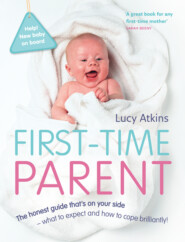По всем вопросам обращайтесь на: info@litportal.ru
(©) 2003-2024.
✖
Blooming Birth: How to get the pregnancy and birth you want
Настройки чтения
Размер шрифта
Высота строк
Поля
Fish: Don’t eat more than two cans of tuna a week. No swordfish, shark and marlin (high mercury levels in these fish can damage the fetus’ nervous system). Avoid sushi (it contains raw fish, a food poisoning risk). Oily fish like salmon, mackerel or sardines are considered to be great as they contain fatty acids known, amongst other things, to improve your baby’s intelligence.
Shellfish: only eat it if you know it’s been thoroughly cooked.
Peanuts: there is some evidence (though not conclusive) that eating them while pregnant can later cause an allergy for them in your child. If you have a family history of allergy generally (asthma, eczema, hayfever, food allergies) the possibility is greater but without such a history the risk is deemed very small.
Toxoplasmosis
To avoid catching toxoplasmosis (an infection that can cause disabilities in a baby) don’t touch the cat litter because in the UK the bug is most commonly found in cat poo. If you do touch it, wash your hands thoroughly afterwards. Uncooked or partially cooked meat can also contain toxoplasmosis so never eat it ‘rare’ and always wash your hands carefully after handling it. Also, wash all fruit, vegetables and salad very carefully.
Where to go for help:
The Toxoplasmosis Trust, run by Tommy’s The Baby Charity. Call their pregnancy information line: 0870 777 30 60
PREGNANCY SUPERFOODS
Put a few of these on your shopping list and try eating at least something each day:8
bananas, oranges and other fresh fruit
dried apricots and prunes
broccoli and other green vegetables
oily fish
whole meal bread
brown rice
lean red meat
chicken and turkey
yoghurt
pulses and lentils
fortified breakfast cereals
nuts (avoid peanuts) and seeds (e.g. sesame)
Superfeeding tips:
Take a snack bag to work of nuts, seeds and dried fruit. Chop fruit onto your breakfast cereal. Make a load of lentil soup and freeze it in lunch-sized portions.
Business eaters
It’s not easy, of course, to cook brown rice when you’re flying business class to New York. In work situations (meetings, planes, offices) you may find yourself ravenous and devouring posh corporate cookies instead of lentil soup. Again, no one is advocating a strict macrobiotic diet here but it might help to think and plan more than you usually do.
1 Think ahead: take bags of dried fruit to work, or on business trips, as snacks. Grab some fruit from the hotel fruit bowl if travelling, to take with you as a snack during the day – don’t fill up on the biscuits and pastries in the boardroom.
2 Ask for healthy options: in restaurants or hotels ask for the more nutritionally sound options: whole meal rolls, fruit or cheese instead of desserts.
3 Avoid the constant ‘treat mentality’. If you do a lot of business travel it’s tempting to go for the croissants at breakfast, the chocolate tart at dinner. This is fine in moderation, but if you travel a lot, you can’t really do this (well you can, but it may not do you much good). Opt for the fruit salad at dinner at least some of the time, eat whole meal toast and cereal for breakfast. Drink plenty of water and remember that the alcohol and caffeine restrictions are still relevant, even if you are in Paris.
A WORD ABOUT VEGETARIANS | If you are vegetarian you may need more iron, calcium and vitamin B12 (in dairy products and eggs) when pregnant, and you also need to get enough protein. Talk to your midwife. More information is also available from: The Vegetarian Society 0161 925 2000. And if you really want obsessive detail you can read Your Vegetarian Pregnancy: a month by month guide to health and nutrition by Holly Roberts but don’t get too hung up here. If you’re following the basic rules above, you are likely to be eating a perfectly healthy diet.
Exercise: the basics
Late for a book launch, about 37 weeks into my first pregnancy, I walked fast across central London in high heels, keeping up with my striding unpregnant colleagues. I ended up spending the last three weeks of that pregnancy immobilized on the sofa. I had strained my ‘symphysis pubis’ – the ligaments that hold your pubic bone together. I felt disabled and my confidence in my body was shaken. In my second pregnancy, through fear of a recurrence, I strained only to lift the box of Thorntons to my lap. This was not ideal either: I grew vast and tired.
The general advice out there on exercise in pregnancy tends to be outdated to say the least – I’ve lost count of how many times I’ve read ‘light housework is OK’. You do have to be sensible about what you do during pregnancy. Strains like the one I had – particularly in later pregnancy and particularly in the pelvic region – are common because your body is swimming in a hormone called ‘relaxin’ which loosens the ligaments in preparation for birth. Indeed, physiotherapists say that nowadays, because we’re all leaping around trying to be as thin as Hollywood starlets, ‘diastasis symphysis pubis’ (called DSP or SPD) – a strain in the joint at the front of your pelvis – is all the rage. This can be severe and even cause permanent damage but none of this means you should sit on your bum for nine months. Indeed, if you’re the fitness type, this idea could really panic you. You don’t have to put your exercise programme on hold while you gestate and indeed, if you’re a couch potato, now is as good a time as any to put down the remote and go for a walk. You do, however, need to follow some basic rules, and remember that pregnancy is not a time to lose weight or become hell bent on shaping up.
Where to go for help:
The National Childbirth Trust offers help and advice on ‘pelvic disfunctions’ like SPD. 0870 770 3236 www.spd-uk.org
Reasons to exercise
Exercise that makes you warm and slightly out of breath is good for most pregnant women. It can strengthen your bones, give you more energy and help you sleep better.
A basic level of fitness can help you cope with the marathon of childbirth.
Exercise can keep you flexible, reduce aches and pains and help other pregnancy symptoms like constipation.
Exercise can help lower your stress levels and lift your mood.
What types of exercise are good?
Low impact exercise, like walking (30–40 minutes, three times a week), yoga (an antenatal class) or swimming (aquanatal classes are good) are all generally safe to do, no matter how unfit you are in everyday life. If you’ve exercised or done certain sports before this pregnancy you should be able to keep going – if it feels good – but DO take the intensity down a notch and again, do set some reasonable parameters with your doctor. Avoid any exercise that is too jerky or has violent impact – such as high-impact aerobics – as this is more likely to strain you.
‘I did spinning up until the last week of my pregnancy,’ says Tiffany Lipelt, a certified health and fitness instructor with a BA in exercise physiology who is also a mother of two children under five, a long distance runner and yoga addict. ‘I have had pregnant women in Tae-bo classes and lifting weights (all have to be modified eventually). It is important to keep your doctor updated and to know that it is not a “results-oriented” work out. It is just to keep you healthy and your mind clear as you get bigger and bigger. Your body and your baby will be your guide – if it doesn’t feel good, it isn’t! It is important to follow basic safety advice, but it is also important to remember that you are an individual and that if you work with your doctor you can come up with a middle ground that suits your exercise needs.’
PELVIC FLOOR EXERCISE | This is one kind of exercise even couch potatoes can excel at. The pelvic floor is the cradle of muscles that keep your bladder and womb in the right place. Pregnancy stretches them. You may leak urine if they are weakened (see Incontinence (#ulink_28c2e74e-c649-5711-b374-d023c0085176)). What to do: Stopping the flow of urine half way through peeing – or trying to – will help you work out what a pelvic floor exercise feels like. People will tell you different ‘numbers’ of exercises you should do, and it can get confusing. Just do some, as often as you can (about ten times a day is good).
Regularly during your day (at traffic lights, when washing up, waiting to cross the road etc.), tighten your pelvic floor, tighten some more, and then some more, as if going three floors up in a lift. Hold five seconds. Release in the same way. Repeat a few times.
Then do a squeeze, hold for a second, and release. Repeat this a few times (well, about ten times would be ideal).
At first this can be frustrating. You may feel you can’t even find the muscles, let alone twitch them. Don’t give up. Practise. Benefits include your long-term gynaecological health, improved sex life, protection against incontinence and, some say, a strong pelvic floor even helps you push the baby out.
General exercise safety rules
1 Do not start anything new (except antenatal classes). If you begin a sudden dramatic increase in your exercise routine on discovering you’re pregnant, or start a new sport hoping to stave off the weight gain, it’s possible you might harm your baby or yourself.
2 Talk to your doctor about any specific sports you do. If your temperature gets too high this can – theoretically – pose risks to the baby as its heart rate will speed up. The best way to gauge how hot is too hot, is to talk to your doctor about how high you should allow your heart rate to go when exercising. Get a heart-rate monitor and use it whenever you are exercising, to keep your heart rate at a level you have agreed with your doctor.
3 Avoid exercises on your back (e.g. sit ups) after 12 weeks. When you are on your back, the weight of the baby sits on the main blood supply from your legs to your heart. This can restrict the oxygen supply to the baby, whose heart rate could then become depressed.







